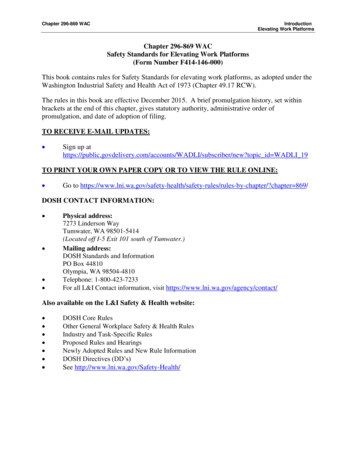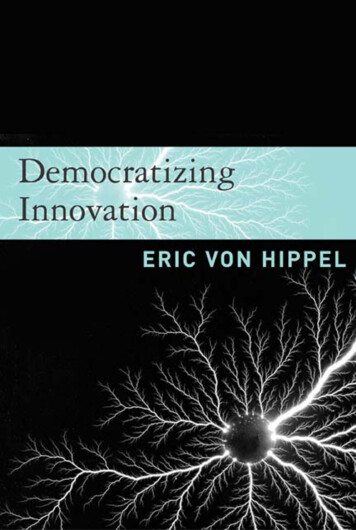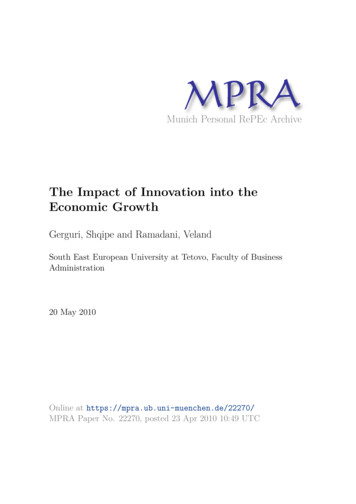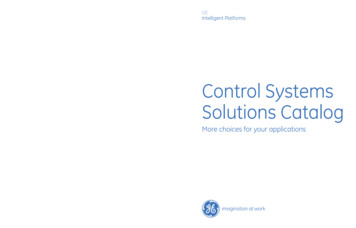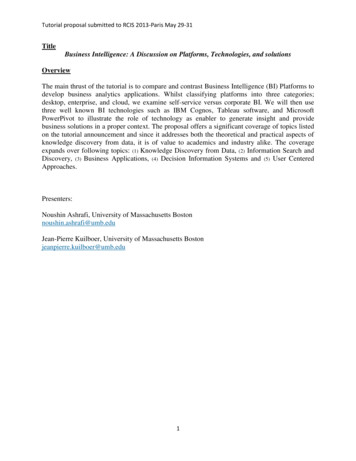
Transcription
tice briefbrief1What are innovation platforms?Innovation platforms are ways to bring togetherdifferent stakeholders to identify solutions tocommon problems or to achieve common goals.They ensure that different interests are taken intoaccount, and various groups contribute to finding solutions. Used by the private sector to gatherinformation and improve networking among keystakeholders in a particular economic sector, theycaught the attention of development agencies at theend of the 1980s. They are now increasingly common in research and development initiatives.But innovation platforms can be difficult and timeconsuming, so must be used with care. This brief explains what innovation platforms are and how theywork, and it describes some of their advantages andlimitations. It is one of a series of briefs on innovation platforms; the other briefs in the series go intodetail on specific aspects of the approach.Spaces for learning and changeAn innovation platform is a group of individuals(who often represent organizations) with differentbackgrounds and interests: farmers, agricultural inputsuppliers, traders, food processors, researchers, government officials etc. The members come together1to develop a common vision and find ways to achievetheir goals. They may design and implement activities as a group or coordinate activities by individualmembers. Individual members can also innovatealone, spurred by the coordinated group activities.DefinitionsAn innovation platform is a space for learning andchange. It is a group of individuals (who often represent organizations) with different backgrounds and interests: farmers, traders, food processors, researchers,government officials etc. The members come togetherto diagnose problems, identify opportunities and findways to achieve their goals. They may design and implement activities as a platform, or coordinate activities byindividual members.Innovation platforms may tackle challenges andopportunities at various levels: in a village or community, in a district or nationwide, or throughout avalue chain or economic sector. They may work at asingle level, or across several levels.Innovation platforms are particularly useful in agriculture because agricultural issues tend to be complex.They involve different biophysical, socioeconomic andpolitical factors, and concern various formal and informal institutions. By bringing together stakeholdersInnovation platforms practice brief 1, November 2013
in various sectors and from different levels, innovation platforms may be able to identify and addresscommon concerns more effectively.Innovation platforms can be used to explore strategies that can boost productivity, manage natural resources, improve value chains, and adapt to climatechange. Some innovation platforms focus on singleissues; others deal with multiple topics.Who uses innovation platforms?Various types of organizations use innovation platforms: Agricultural research organizations use innovation platforms to help make their researchmore relevant and to facilitate the adaptation and dissemination of findings. They forceresearchers to look beyond their own disciplinary or commodity boundaries and consider thewhole picture (see Brief 3). Development agencies and NGOs find themuseful to identify areas for interventions, to ensure that the interventions are appropriate forparticular situations, and to enable stakeholdersto influence policy making and developmentactivities (Brief 12). Local and national governments use them toimprove policy making, links with clients, andtheir outreach services for citizens (Brief 2). Donors regard innovation platforms as a way toimprove the targeting and effectiveness of development interventions. While they may sponsor innovation platforms, they are not normallymembers themselves.Some stakeholders are crucial members of innovation platforms: Farmers and other rural people use innovationgroups to express their interests and guideactivities that are intended to benefit them. The private sector, including traders, input suppliers, service providers, processors, wholesalers and retailers, can benefit from innovationplatforms that aim to boost economic activitiesand make value chains more profitable.2Examples of innovation platformsThe Consortium for Sustainable Development of theAndean Ecoregion (www.condesan.org) uses innovation platforms to address issues in natural resourcemanagement. They engage local actors to discuss howto share benefits and resolve conflicts.In the Fodder Adoption Project, the International Livestock Research Institute (fodderadoption.wordpress.com/) used innovation platforms in Ethiopia to improvelivestock feeding. Through platform discussions, theproject’s initial narrow focus on feed broadened toinclude the procurement of improved crossbredcows, new milk transportation arrangements, andthe establishment of a dairy cooperative.Innovation platforms are also used in several otherprojects notably the Nile Basin Development Challenge (http://nilebdc.org), and the imGoats (http://imgoats.org) and PROGEBE (http://cgspace.cgiar.org/handle/10568/27871) projects.In southern Africa, the International Crops ResearchInstitute for the Semi-Arid Tropics (www.icrisat.org)used innovation platforms to improve the production and marketing of goats. Innovation platformshelped lower transaction costs in the value chain,meant that farmers could make a bigger profit, andensured that the market could guide investment ingoat production.The Convergence of Science–Strengthening InnovationSystems program (www.cos-sis.org) used innovationplatforms in West Africa to improve smallholder agriculture. The platforms studied bottlenecks in production systems and induced institutional changes in valuechains and policymaking.The International Center for Tropical Agriculture andits partners (www.alianzasdeaprendizaje.org) developed a regional ‘learning alliance’ in Central America toimprove market access for farmers through collaborative innovation.The Forum for Agricultural Research in Africa (www.fara-africa.org) promotes the use of innovation platforms in integrated agricultural research for development programs that target productivity, markets,natural resource management and policy issues.More: : ilri.org/taxonomy/term/58Innovation platforms practice brief 1, November 2013
Innovation platforms tend to follow a seven-step cycleHow innovation platforms work Test and refine solutions. Solutions must betested and adapted to make sure they work.Farmers may test new farming methods; traders may try offering more for higher grades ofproduce; an input supplier may market-test anew type of product. The innovation may be anew technology (a new type of seed or farmingtechnique), or an institutional change (a policyadjustment or a new way to manage marketing). The innovation platform coordinates theseexperiments and monitors whether they aresuccessful (Briefs 3 and 5). Develop capacity. In most cases, it is necessaryto develop the capacity of different actors inorder for the solutions to succeed. Farmersmay need training in a new technique; cooperatives may need help with organization andbookkeeping; new ways may be needed tomultiply and distribute seed or to manage themarketing of produce. The innovation platformidentifies these needs and finds ways to developthe capacity required (Brief 8). Implement and scale up. If the innovation is successful, the innovation platform works with itsmember groups to get it adopted widely. Thatmay mean documenting and publicizing theinnovation, arranging training and study visits,persuading other groups to adopt it etc. (Briefs7 and 9).Innovation platforms generally follow several steps. Initiate. Any stakeholder group can initiate innovation platforms, but it is usually a researchor development organization, a governmentagency or an NGO that does so. This organization identifies the broad focus area of the innovation platform, identifies the various stakeholders, brings them together, and convenes the firstfew meetings. It identifies someone to facilitatethe innovation platform: perhaps one of its ownstaff, or someone else from outside (Brief 10). Decide on focus. The platform membersdiscuss the focus area and identify bottlenecks,problems and opportunities. They may refinethe focus further, expand it, or shift it to adifferent set of issues. They gather information from various sources, including researchfindings, current practices, local knowledge andpolicy guidelines (Brief 7). Identify options. The platform members decidewhat they want to do to solve the problems ortake advantage of the opportunities that theyhave identified. The range of options may bewide. For example, they may decide to test newvarieties of a crop, explore ways to improvesupplies of inputs, promote the marketing of aproduct, or press for a change in governmentpolicy (Briefs 3 and 6).3Innovation platforms practice brief 1, November 2013
Analyse and learn. Learning what has succeeded and what has not is an important partof innovation platforms, especially those with aresearch focus. This information is fed back toplatform members so they can identify furtherchanges to be made (Briefs 3, 5, 8, 10 and 12).Different words, same idea Concentration and innovation group Innovation network Innovation coalition Innovation configuration Multi-stakeholder platform Association interprofessionnelle (French) Plataforma de inovação (Portuguese)Links to other bodies. The members of an innovation platform provide vital links to the organizations or groups they represent. Each memberrepresents his or her organization, and is expectedto communicate the platform’s suggestions andactivities back to his or her peers.Linking innovation platforms. Some problemscannot be addressed at one level: a district-levelplatform may identify a policy that needs to bechanged at a national level. It may be useful to forminnovation platforms at several levels (community,district, national) to address problems at each one.Innovation platforms at each level should be linkedto feed ideas and information up, down and sideways (Brief 9).Dynamic processesInnovation platforms are a systematic attempt tofacilitate change through joint action. While theyare structured, they are also flexible, changing inresponse to the current situation.Changing focus. As problems are solved and newissues emerge, the activities and focus of an innovation platform may change over time. It is theplatform members who decide.Changing membership. The membership of aninnovation platform may change over time as needsarise.I The platform may invite new members to join:for example, a platform focusing on agriculture mayinvite someone with expertise in water to join ifthis emerges as a key issue in farm production. Aplatform could bring in outsiders on a short-termor one-off basis to provide information or advice.Changing responsibilities. The management ofthe innovation platform may shift over time fromthe initiating organization to one or more of themembers. For example, a farmer organization orgovernment agency may take over responsibility forcoordinating the platform.Temporary or permanent? Innovation platformsmay be temporary: they exist only as long as necessary to solve a problem. Or they may be extendedas new issues and opportunities emerge. If so, it isnecessary to find ways to fund the platform and itsactivities after initial project funding ends.4Innovation platform actors and stakeholdersBenefits of innovation platformsStrengths of innovation platforms include: They facilitate dialogue and understandingamong stakeholders and provide a space forthem to create a common vision and mutualtrust. They offer a neutral space to air disagreements and conflicts, and for members to statetheir needs and requirements (Brief 4). They enable partners to identify the bottlenecks hindering innovation, and develop solutions beyond what individual actors can achievealone, for example, in infrastructure, institutionalchange and policy development (Brief 2). They create motivation and a feeling of ownership of the solutions that they develop: Peoplereadily buy into solutions they have beeninvolved in developing. They facilitate upward communication. Theyenable weaker actors (such as small-scale farmers) to express their views on an equal basisInnovation platforms practice brief 1, November 2013
with powerful actors (such as processors orthe government). They empower communitiesto demand and negotiate for services from thegovernment and support organizations. They lead to better-informed decisions. Innovation platforms enable joint learning andcooperation among diverse actors to solveproblems and reduce uncertainties. Farmers canlearn how to sell their products; policymakersgain evidence to use in creating a more enablingenvironment where innovations can happen. They contribute to capacity development. Byimproving communication, learning and exposure to new people and ideas, innovationplatforms help members to clarify their roles,organize themselves, and adapt to unforeseenchanges and new opportunities (Briefs 7 and 8). They make innovative research possible. Innovation platforms create opportunities forresearch to be demand-driven, to find criticalissues for investigation, and to disseminate research outputs. Platform members are involvedin the research process, and are more likely tobe convinced by the findings (Brief 3). They enhance impact. Farmers can improvetheir agricultural productivity and profitabilityand improve how they manage natural resources.Value chain actors can engage more effectively in the market. Policy making can be moreparticipatory and appropriate for solving issueson the ground (Brief 12).ConstraintsInnovation platforms are not the solution to allproblems. Because they are not rigid or predictable,they can lead a research or development programin unexpected directions (which may be a goodthing, but can be hard to justify to senior managersand donors).Depending on the circumstances, other approaches,such as more traditional research coordinationmeetings, stakeholder consultations, or participatory research methods, may be more appropriate.All these methods can be used in conjunction withinnovation platforms. Progress and success depends on the full buy-inof the members. Members have to be willing towork together and trust each other. Social andinstitutional conflicts, lack of political will, andpower structures can hinder the growth of theinnovation platform (Brief 4). Innovation platforms can be difficult and costlyto implement. They require a range of facilitation and research expertise—which may notbe available. The costs of fostering partnershipsshould be seen as an investment—requiring along-term perspective (Brief 10). They require a long-term perspective: engagingactors and developing relationships takes time.Necessary investments in infrastructure andpolicies are often long-term. Achieving visibleoutputs may take longer than a project allows. It can be difficult to monitor and evaluate innovation platforms in a systematic way. Theiroutcomes depend on many factors, and manyother factors may intervene to reinforce ormask their effects (Brief 5). Shortcuts are risky. Developing and promotinginnovation requires systems thinking, includingtechnical as well as institutional innovations andpolicy adaptations. There is a danger of regarding innovation platforms merely as forums totransfer and disseminate technology. Tangible outputs are needed to sustain the members’ interest and commitment to the innovationprocess. Without them, they may lose interest.Related approaches Public–private partnerships. These may focuson developing technologies such as hybridmaize and biotech together with industry. Butthey may neglect stakeholders such as farmers and government. Participatory research. This is useful to adapttechnologies to farm conditions. But it mayfail to consider outside constraints, such asissues or bottlenecks in the value chain. Learning alliances. These enable groups offarmers or traders to work together andlearn from each other. But they rarely bring inother perspectives.5Innovation platforms practice brief 1, November 2013
SustainabilityHow to ensure sustainability of the process? Oftenthe platform itself does not have to be sustainable!Once capacity for innovation (Brief 8) is establishedin a system, the platform itself may not be required.It may be useful for certain types of platforms, suchas higher-level policy-oriented platforms, or thosethat facilitate information exchange, to be sustainedover time. Funding and support for such platformsneeds to be found.ReferencesKlerkx, L., van Mierlo, B. and Leeuwis, C. 2012. Evolution ofsystems approaches to agricultural innovation: Concepts,analysis and interventions. In: Darnhofer, I., Gibbon, D. andDedieu, B. (eds), Farming systems research into the 21st century:The new dynamic. Dordrecht: Springer: 457–83.Lundy, M.,Gottret, M.V. and R. Best. 2012. Linking research anddevelopment actors through learning alliances in agriculturalinnovation systems: An investment sourcebook. Washington, DC:World Bank. 344–348.Nederlof, S., Wongtschowski, M. and van der Lee, F. 2011. Putting heads together. Agricultural innovation platform in practice.Bulletin 396. Amsterdam: KIT.Pali, P. and Swaans, K. 2013. Guidelines for innovation platforms:Facilitation, monitoring and evaluation. ILRI Manual 8. Nairobi:ILRI. ion platforms are widely used in agricultural research to connect different stakeholders to achieve common goals.This is one of a series of briefs to help guide the design and implementation of innovation platforms. A contribution tothe CGIAR Humidtropics research program, the development of the briefs was led by the International Livestock ResearchInstitute; the briefs draw on experiences of the CGIAR Challenge Program on Water and Food, several CGIAR centres andpartner organizations.CreditsAuthors:Sabine Homann-Kee Tui (ICRISAT), Adewale Adekunle (FARA), MarkLundy (CIAT), Josephine Tucker (ODI), Eliud Birachi (CIAT), Marc Schut(Wageningen UR), Laurens Klerkx (Wageningen UR), Peter Ballantyne(ILRI), Alan Duncan (ILRI), Jo Cadilhon (ILRI) and Paul Mundy (ILRI)Artwork: Beniyam Seyoum, Tewodros Girma and Alfred OmbatiEditors: Paul Mundy and Peter BallantyneLayout: Meron MulatuOther briefs in this series1 What are innovation platforms?2 Innovation platforms to shape national policy3 Research and innovation platforms4 Power dynamics and representation in innovation platforms5 Monitoring innovation platforms6 Innovation platforms for agricultural value chain development7 Communication in innovation platforms8 Developing innovation capacity through innovation platforms9 Linking action at different levels through innovation platforms10 Facilitating innovation platforms11 Innovation platforms to support natural resource management12 Impact of innovation platformsThis document is licensed for use under a Creative Commons Attribution – Noncommercial – Share Alike 3.0 Unported Licence.November 2013
gies that can boost productivity, manage natural re-sources, improve value chains, and adapt to climate change. Some innovation platforms focus on single issues; others deal with multiple topics. Who uses innovation platforms? Various types of organizations use innovation plat-forms: Agricultural research organizations use inno-

